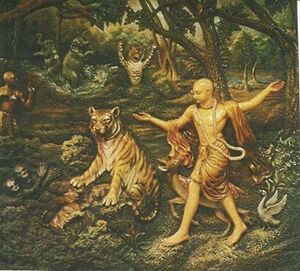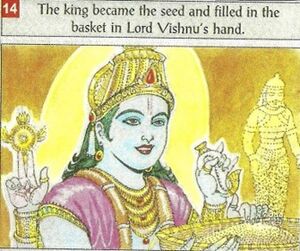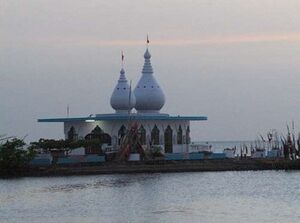Talk:Bhakta Yogī-s transform ordinary places to tīrtha-s
By Vishal Agarwal
Many Hindu pilgrimage centers owe their origin to their sanctification or association with spiritually elevated Sants and Bhakta-s. The scriptures of Bhakti declare that it is not just Divine manifestations that transform ordinary places into sacred sites, but also the presence of Bhakta-s because the latter are permeated with the Divine spirit.
Pilgrim centers become holy because of the presence of Bhakti Yogī-s, specific karmas become pious karmas because the bhaktas performed them, and scriptures become validated (or become true) because Bhaktas had lived their teachings and because Bhakti Yogī-s are filled with Divinity. Nārada Bhakti Sūtra 69-70
The following narratives illustrate the re-discovery of forgotten sacred sites due to the spiritual power of devotees, or the creation of new pilgrimage centers by them.
Discovery Of Ayodhya and its Sacred Sites
Emperor Vikramaditya and his troops passed through a forest after driving the Scythian invaders out of India. There, a Sadhu informed the victorious Emperor, “This forest marks the site of the sacred city of Ayodhya where the Divine King Rama had once ruled. With time, the city has become desolate and a forest now occupies its place. But if you meditate on Rama, you will have a glimpse of Him in your heart whenever you are at a spot associated with His divine acts.” Emperor Vikramaditya did as he was told, and was able to unearth 360 sacred sites related to the life of Rama. He then moved his capital city to Ayodhya, which was restored to its ancient glory.
Discovery Of Vrindavan
Likewise, the glories of Vrindavana were forgotten as a result of several centuries of Islamic rule. This sacred region lay between Delhi and Agra, two seats of Muslim political power in N India. The Sultans utterly destroyed the region, and let it become a desolate forest of scrub and thorny thickets. They even used the region as a hunting ground, killing animals their being the ultimate sacrilege of the sensibilities of Vaishnavite Hindus.
But, a great saint arose in Bengal, named Chaitanya Mahaprabhu. When he visited the desolate region, he was able to see with his spiritual eyes the former associations of different sports with Bhagavan Krishna. Back in India, he blessed Sri Rupa Goswami and Sri Sanatana Goswami and tasked them with going north to Vrindavana, and revive its former spiritual glory. Blessed by the Chaitanya, the two saints spent several decades in that area, devotedly and persistently unearthing numerous sacred sites associated with the early life of Krishna. In those roughly 75 years, the followers of Chaitanya Mahaprabhu attracted several Hindu princes and traders who sponsored the construction of beautiful temples to Krishna in that region. Although many of these temples were erased just two generations later by the bigoted Muslim Emperor Aurangzeb, the grandson of Jehangir, the glory of Vrindavan could not be completely extinguished this time.
Shri Nārāyaṇa Bhatta, a scholarly Brahmana from Madurai, who lived in Vrindavan in the early 16th century, also saw places associated with Krishna’s childhood in his visions and helped reclaim many of them[1].
Emperor Kuru: How Kurukshetra got its name
King Kuru of the Puru-Bharata dynasty ruled a kingdom on the banks of the Sarasvati River, which flowed in northern India at the border of the Indian states of Haryana and Punjab. One day, his elderly prime minister asked permission to retire and settle down in Varanasi, on the banks of the Ganga. When the King asked for a reason, he replied, “Varanasi is a very holy city and Ganga washes away our sins. It is said that Bhagavān Shiva grants Moksha to whosoever dies there. Therefore, please permit me to leave your kingdom.”
The King thought, “What can I do to make my kingdom as holy as Varanasi so that my people do not have to travel this long distance for Moksha? After all, isn’t Saraswati River also a very holy river?” He called a meeting of his ministers and asked them for a solution. Many of them discouraged him from making any attempt in this regard. Some of them suggested that he should talk to Rishis who lived in the forests on the banks of Kurukshetra.
The King approached the Rishis. They said to him, “Let us warn you that to make this place as holy as Varanasi is a very difficult task. You must pray to Shiva and Yama – the Devta of Death, to suggest a way.” But King Kuru was not dissuaded. He said, “Bhagiratha and his ancestors too worked very hard to get Ganga from heaven to this earth. I too am very determined to make my kingdom as holy as Varanasi.” The Rishis blessed him, and the King started worshipping and meditating on Shiva and Yama.
They were pleased and granted a wish to King Kuru. The King said, “I request Bhagavān Shiva to loan me his bull Nandi, and Yama to loan me his buffalo. I will till the plains of my kingdom with these two divine animals, and this will surely make it very holy.” Shiva and Yama loaned their mounts to King Kuru, who became a farmer and started tilling the land with great effort, while chanting, “Om Namashivaaya, Om Namo Nārāyaṇāya.”
After many years of effort, he tilled the entire land in his kingdom. Then he worshipped Bhagavān Vishnu to ask him what should be done next. Vishnu answered King Kuru’s prayers and said, “You have scratched off all evil from this land by plowing it with Nandi and the buffalo of Yama. But you must also now plant the seeds of Dharm to make it holy. No one is as Dharmic as you King Kuru, because you have worked hard unselfishly for the sake of your people. Will you agree to become the seed for sowing?” King Kuru replied, “Bhagavān, what can make me happier than becoming the seed that will make the land of my people prosperous and holy?”
Bhagavān Vishnu then transformed the body of King Kuru into a heap of grain and then sprinkled the seeds all over the land. When abundant crops had grown in the land, Vishnu then summoned the soul of King Kuru and granted him a wish. King Kuru’s soul replied, “Please make this land as holy as Varanasi, and let it hereafter be known as Kurukshetra.” Bhagavān Vishnu granted his wishes.
Even today, Hindus often visit Kurukshetra for worship and prayer and perform the funeral ceremonies of their dead ancestors in that area in the hope that Bhagavān will bless their souls. Sometime later, Bhagavān Krishna too appeared in Kurukshetra and revealed to his friend Arjuna the Bhagavad Gita, the holiest Hindu scripture.
Pandit Shivdas Sadhu constructs a Temple in the Ocean
More than 150 years ago, the British started taking people from India to work on sugar plantations on the island of Trinidad in the Atlantic Ocean. Most Indians were Hindus, but the British did not allow them to practice their Hindu Dharm. One Hindu man named Shivdas Sadhu built a small Mandir of Shiva on a farm. But the government broke it, saying, "The land does not belong to you.” Shivdas said, “The land might be yours, but the sea belongs to no one!” So every day after work, Shivdas started carrying stones and rocks in a leather bag on his bicycle. He started putting them on the coast of the sea, and slowly built a long path in the ocean. At the end of the path, he then constructed a small island. After 25 years of hard work, he finally constructed a Hindu Mandir on that island.
The government of Trinidad and Tobago recognized his dedication to Hindu Dharm and declared the Mandir as a national monument. This means, that Trinidad recognizes the Mandir built by Shivdas as an important part of the culture of that country! Let us learn from Shivdas, build Mandirs to Bhagavān, and practice our Dharm wherever we go, even if the local government puts hurdles in our way.
References[edit]
- ↑ Nābhādāsa (Nābhā Goswāmī). Śrī Bhaktamāla with Commentary by Śrī Priyadāsa. Translated by Bhūmipati Dāsa, edited by Pūrṇaprajna Dāsa, Rasbihari Lal and Sons, 2017, text 87.



